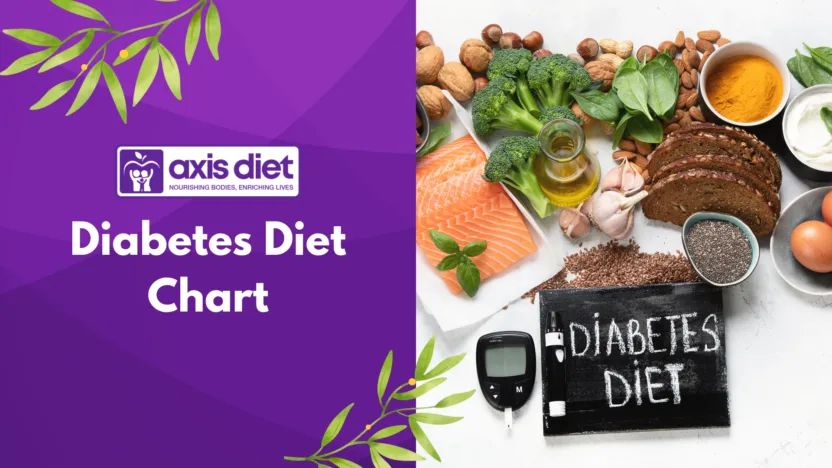The Indian diabetes diet chart is essential for those managing diabetes. It emphasizes nutritious foods that maintain blood sugar levels and overall health. This guide details a well-structured daily menu, explains portion sizes, and highlights foods that should be included or avoided to effectively manage diabetes while enjoying Indian cuisine.
Understanding Diabetes and Its Dietary Needs
Understanding carbohydrates, proteins, and fats is essential for managing diabetes effectively. Each nutrient has a significant role that impacts blood sugar levels and overall health. Proper understanding and selection of these nutrients can help diabetics maintain optimal health.
Carbohydrates are the most significant nutrients affecting blood sugar levels. They break down into glucose, which provides energy. However, not all carbohydrates are created equal. Simple carbohydrates, found in sugary foods, can cause rapid spikes in blood sugar. On the other hand, complex carbohydrates, such as those found in whole grains and legumes, release glucose more slowly, making them a better choice for diabetics. These foods also provide fiber, which aids in digestion and helps regulate blood sugar levels. Incorporating whole grains like jowar or bajra into meals can enhance dietary quality while controlling blood sugar responses.
Proteins are essential for the body’s repair and growth. They have a minimal direct impact on blood sugar levels, making them crucial for diabetics. Incorporating lean protein sources, such as chicken, fish, or plant-based proteins like lentils and beans, can help maintain muscle mass and promote a feeling of fullness. This promotes better meal planning and reduces the likelihood of overeating, which is vital for managing weight and blood sugar levels. Choosing diverse protein sources contributes to a balanced diet that supports overall health.
Fats also play a role in blood sugar management, but the type of fat consumed matters significantly. Healthy fats, such as those found in nuts, seeds, and certain oils, can be beneficial. They help improve insulin sensitivity and can stabilize blood sugar levels when incorporated in moderation. Saturated and trans fats, often found in processed foods, should be limited as they can lead to cardiovascular issues. For healthier fat choices, consider incorporating recipes using healthy oils like olive oil found in discussions about heart health, such as in this blog explaining the benefits of different oils.
Overall, building a diabetes-friendly diet requires careful selection of these nutrients. A balanced diet that includes adequate carbohydrates, proteins, and healthy fats can significantly influence blood sugar control. By understanding how each nutrient operates within the body, diabetics can make informed food choices and improve their health outcomes.
Key Nutrients for a Diabetes-Friendly Diet
For individuals managing diabetes, understanding key nutrients is vital for maintaining balanced blood sugar levels. The three critical macronutrients—carbohydrates, proteins, and fats—each play distinct roles in overall health and dietary planning.
Carbohydrates are often viewed with caution by diabetics, but choosing the right type is crucial. Complex carbohydrates, such as whole grains and legumes, release glucose into the bloodstream slowly. This steady release helps prevent quick spikes in blood sugar. Foods like brown rice, quinoa, and millets are excellent sources. In contrast, refined carbohydrates, often found in white bread and sugary snacks, can lead to rapid fluctuations in blood sugar. Therefore, incorporating sources of dietary fiber along with carbohydrates, such as vegetables and fruits, can further support healthy digestion and glucose control.
Moving on to proteins, these macronutrients are essential for preserving muscle mass and overall health. They assist in regulating blood sugar levels by slowing down the absorption of carbohydrates, thus providing a more stable energy source. Lean sources of protein, such as dal, chicken, fish, and curd, are ideal for diabetics. Additionally, plant-based proteins such as tofu and chickpeas are also beneficial, offering fiber content that aids in glycemic control.
Meanwhile, fats are crucial for hormone production and help the body absorb fat-soluble vitamins. It is vital for diabetics to focus on healthy sources of fat. Monounsaturated and polyunsaturated fats, found in foods like olive oil, avocado, and nuts, can help improve cholesterol levels and support heart health. In contrast, saturated and trans fats, commonly found in fried and processed foods, should be limited as they may contribute to insulin resistance and heart-related issues.
Inclusion of micronutrients like vitamins and minerals also plays a role in managing diabetes. Vitamins such as C, D, and E, along with minerals like magnesium and chromium, are significant for overall metabolic health and insulin sensitivity. Foods rich in these nutrients include leafy greens, broccoli, and nuts.
Understanding how these nutrients interact with the body can significantly aid individuals in managing diabetes. For further insights on essential dietary choices, visit diet for diabetic patients.
Creating a Balanced Indian Meal Plan
Creating a balanced Indian meal plan for diabetes management involves incorporating traditional foods while ensuring nutritional needs are met. A successful meal plan prioritizes low Glycemic Index (GI) foods, balanced macronutrients, and adequate fiber intake. Here’s a day’s framework that highlights meals and snacks suitable for maintaining stable blood sugar levels.
Breakfast can consist of:
- Oats porridge topped with slices of almonds and a sprinkle of cinnamon for flavor.
- Moong dal cheelas served with mint chutney provide protein along with complex carbohydrates.
For a mid-morning snack, consider:
- A small bowl of mixed fruits such as berries or papaya, which are lower in sugar and packed with vitamins.
- Buttermilk or chaas spiced with cumin for hydration and gut health.
Lunch options may include:
- Brown rice or quinoa served with a hearty mixed vegetable curry made with seasonal produce.
- A side of dal, which is high in protein and fiber, helps keep blood sugar stable.
Afternoon snack ideas could be:
- Roasted chickpeas or sundal (spiced chickpeas), which offer protein without raising blood sugar levels.
- Vegetable sticks, such as celery or carrot, paired with hummus for fiber and healthy fats.
For dinner, try:
- Whole wheat chapatis with palak (spinach) curry or cluster beans, rich in nutrients.
- A bowl of curd with a dash of black pepper aids digestion and provides probiotics.
Finally, for a late-night snack, opt for:
- A handful of nuts, such as walnuts or cashews, which are perfect for heart health.
- Green tea with a hint of lemon can also help manage sugar levels.
These meal ideas illustrate how traditional Indian foods can be integrated into a diabetes-friendly meal plan. The diversity ensures that essential nutrients are consumed while keeping meals enjoyable and satisfying. For more insights on nutritional understanding and meal preparation, consider exploring diet for diabetic patients.
Portion Control and Its Importance
Portion control plays a significant role in managing diabetes effectively. It involves understanding how much food to consume in order to maintain stable blood sugar levels. Eating the right portions helps regulate carbohydrate intake, which is vital for diabetes management. Excessive portion sizes can lead to spikes in blood glucose, making it essential to stay mindful of meal sizes.
Practical tips for measuring portions can transform how one approaches meals. Here are some effective methods:
- Use a food scale: Weigh raw ingredients to get accurate measurements.
- Invest in measuring cups: These can help you portion grains, vegetables, and fruits precisely.
- Visual cues: Familiarize yourself with standard serving sizes. For instance, a serving of rice is roughly the size of your fist.
- Prep meals in advance: Preparing meals in containers allows for controlled portions and reduces the temptation to overeat.
- Read food labels: They provide serving sizes and help in understanding the carbohydrate content in packaged foods.
Adapting portion sizes based on individual dietary needs is also crucial. Each person’s caloric needs vary depending on factors like age, weight, activity level, and overall health. Monitoring blood sugar levels can guide adjustments in portion sizes. It’s essential to pay attention to how different amounts of carbohydrates affect blood sugar levels.
For those who incorporate traditional Indian foods into their diet, balancing portions with cultural dishes can be challenging. It’s wise to be familiar with the carbohydrate content of Indian staples. For example, one should consider the portion size of foods like chapatis, rice, or lentils, as they can contain substantial carbohydrates.
Incorporation of lower-carbohydrate vegetables can also help in meal preparation. Filling half your plate with non-starchy vegetables can help you feel full without contributing significantly to your carbohydrate intake.
Staying hydrated is another important aspect that often gets overlooked in portion control. Sometimes, thirst can be confused with hunger. Drinking water before meals can help regulate appetite and support portion control.
Being mindful and intentional about food portions not only helps regulate blood sugar levels but also facilitates a healthier lifestyle. This conscious effort can pave the way for a more balanced approach to meals while enjoying traditional Indian cuisine. For some structured meal planning support, exploring healthy eating portion control tips can be beneficial.
Foods to Include in Your Diet
Choosing the right foods is essential for managing diabetes effectively. An Indian diabetes diet can incorporate many traditional foods that help maintain stable blood sugar levels. Incorporating these foods into daily meals offers not only nutrition but also enhances the flavors of Indian cuisine.
Whole Grains: Whole grains are rich in fiber, which aids in blood sugar control. Options include:
- Brown Rice: This is a great alternative to white rice, offering more fiber and nutrients.
- Quinoa: A protein-rich grain that has a low glycemic index, making it ideal for diabetics.
- Millets: Varieties like ragi and jowar are high in fiber and low in carbohydrates.
- Whole Wheat: Opt for whole wheat flour for chapatis and other traditional breads.
Vegetables: Non-starchy vegetables should be included in every meal. They are low in calories and have a low glycemic index. Examples include:
- Spinach: Packed with nutrients and adds volume without the calories.
- Broccoli: Rich in fiber and antioxidants, it helps in reducing blood sugar levels.
- Cauliflower: A versatile vegetable that can be used as a rice substitute.
- Drumsticks: Famous for their nutritional value, they can be added to curries and soups.
Fruits: While fruits contain natural sugars, certain varieties are better suited for a diabetes-friendly diet due to their low glycemic indexes. Recommended fruits include:
- Apples: High in fiber and can help regulate blood sugar levels.
- Guava: Rich in fiber and has a low glycemic index.
- Berries: Blueberries and strawberries are packed with antioxidants and beneficial for heart health.
- Citrus Fruits: Oranges and lemons are low in calories and high in vitamin C.
Proteins: Incorporating adequate protein can help control hunger pangs and blood sugar levels. Good sources include:
- Pulses: Lentils and chickpeas offer high protein with a low glycemic index.
- Fish: Options like salmon are great sources of omega-3 fatty acids.
- Chicken: Skinless chicken can be included for lean protein needed for muscle repair and growth.
- Curd: Low-fat curd or yogurt promotes gut health and provides protein.
Implementing these foods can foster better control over diabetes while celebrating the richness of Indian culinary traditions. For a comprehensive guide to diabetes-friendly meals, consider visiting this page.
Foods to Avoid for Optimal Diabetes Management
Managing diabetes effectively requires more than just knowing which foods to include in your daily diet. It’s equally important to understand what to avoid. Certain foods can lead to unwanted spikes in blood sugar levels, making it crucial for individuals with diabetes to limit or eliminate them from their diets. This chapter highlights foods and ingredients to steer clear of for optimal diabetes management, particularly focusing on sugars and refined carbohydrates.
Firstly, sugary foods are primary culprits when it comes to blood sugar spikes. Items like candies, pastries, and sugary beverages have high glycemic indices, triggering rapid glucose release into the bloodstream. The body struggles to process these sugars effectively, leading to insulin resistance over time. Thus, limiting consumption of items like:
- Soft drinks and fruit juices with added sugar
- Cakes and pastries
- Jellies, syrups, and other sweet spreads
- Ice creams and sugary desserts
Secondly, refined carbohydrates should be significantly reduced. These are found in foods that have been processed to remove fiber and nutrients. White bread, white rice, and many snack foods fall into this category. The rapid breakdown of these carbs into glucose can cause significant spikes in blood sugar levels. It is advisable to avoid:
- White bread and pasta
- Regular white rice
- Baked goods made with white flour
- Processed snack foods
Moreover, another category to consider is high glycemic index (GI) foods. Foods with a high GI can raise blood glucose levels quickly. This includes not only sugars and refined carbs but also starchy vegetables like mashed potatoes. Such foods can lead to overconsumption while providing minimal nutritional benefits. Therefore, it’s wise to limit:
- Mashed or fried potatoes
- Corn and corn-based products
- Instant oatmeal
Along with avoiding specific foods, added sugars often lurk in unexpected places. Many condiments such as ketchup and salad dressings can contain hidden sugars, making it crucial to check labels. Additionally, artificial sweeteners should also be approached with caution, as they may create cravings for sweet foods, leading to a cycle of consumption that can be hard to break. It’s recommended to carefully assess food labels and ingredient lists.
For a detailed look at how to navigate food choices as part of a diabetes-friendly diet, you can visit this article on diabetes diet management. Understanding what to avoid lays a strong foundation for managing diabetes effectively, allowing you to make informed decisions about your dietary choices.
Consultation for Personalized Dietary Guidance
Personalizing dietary plans for diabetes management can significantly enhance one’s overall health and well-being. A personalized diet focuses on the unique nutritional needs of an individual, taking into account various factors like age, gender, activity level, and specific medical conditions. This tailored approach is especially vital for those managing diabetes, as it enables effective blood sugar control and helps prevent complications associated with the condition.
One of the primary benefits of a personalized diet plan is its adaptability. Each person responds differently to certain foods. What may cause a significant blood sugar spike in one individual might not affect another in the same way. By working with a knowledgeable professional, individuals can identify their specific triggers and allocate appropriate food choices that support their health.
- Customized Meal Plans: A dietitian can create meal plans that fit one’s lifestyle and dietary preferences, making adherence easier.
- Nutritional Education: Consulting a dietitian provides valuable insights into food choices, portion sizes, and meal timing.
- Support with Weight Management: A personalized approach can help address weight issues, which is crucial for many individuals with diabetes.
- Enhanced Monitoring: Regular consultations allow modifications based on changing health conditions or goals.
- Behavioral Guidance: Experts can offer strategies for overcoming challenges related to food cravings, emotional eating, or social situations.
Diabetes requires more than just basic dietary choices; it demands a comprehensive understanding of how various foods impact blood sugar levels. A dietitian can use tools like the glycemic index to help tailor food selections. This can aid in choosing foods that support stable glucose levels while ensuring nutritional adequacy.
Regular consultations with a dietitian can also foster accountability. When individuals are held accountable for their eating habits, they are more likely to stick to their dietary goals. This can lead to better outcomes in diabetes management, ultimately reducing the risk of complications such as cardiovascular disease, neuropathy, or kidney issues.
For anyone managing diabetes, the benefits of personalized dietary guidance are clear. It is not just about what to eat or avoid. It encompasses a deeper understanding of personal health, preferences, and lifestyle choices. Connecting with a qualified dietitian is a productive step towards achieving better diabetes management. For expert guidance tailored to individual needs, consider consulting a professional at this link.
Final words
Adhering to the Indian diabetes diet chart can significantly improve blood sugar control and overall well-being. By carefully selecting foods, portions, and meal timings, individuals with diabetes can enjoy flavorful meals while maintaining their health. For personalized advice, consider a diet consultation.
The content provided in this blog post is intended for general knowledge and informational purposes only. It should not be considered a substitute for professional medical advice, diagnosis, or treatment. For personalized health recommendations tailored to your individual needs, we highly encourage you to connect with our certified clinical dietitians. Visit us at Axis Diet Consulting to schedule a consultation and take the first step toward your health journey!





